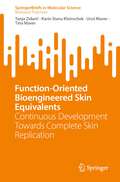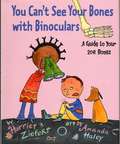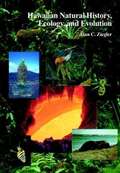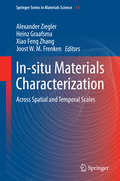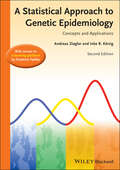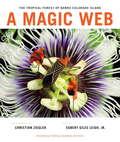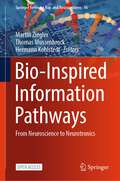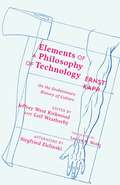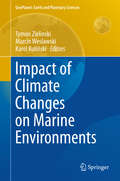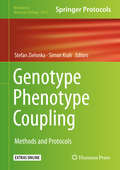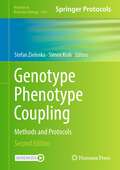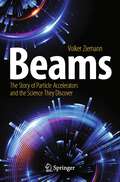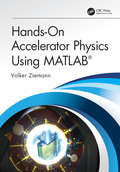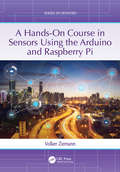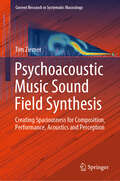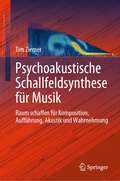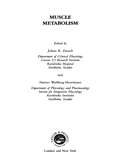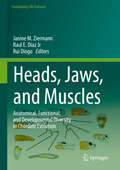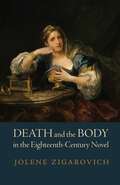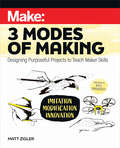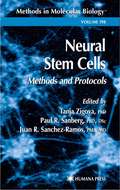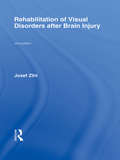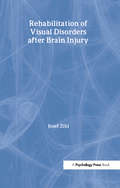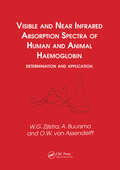- Table View
- List View
Function-Oriented Bioengineered Skin Equivalents: Continuous Development Towards Complete Skin Replication (SpringerBriefs in Molecular Science)
by Tanja Zidarič Karin Stana Kleinschek Uroš Maver Tina MaverThe book Function-oriented bioengineered skin equivalents - continuous development towards complete skin replication aims to provide potential readers with a comprehensive summary of the available information on various in vitro skin models, from historical background to different modeling approaches and their applications. Particular emphasis is placed on presenting the current technological components available for the development of engineered skin equivalents by summarizing advances in cell cultivation, materials science, and bioengineering. Using examples of the current-state-of-art, we describe the advantages, limitations, and challenges of developing in vitro skin models for successful use in clinical applications and skin-related research.
You Can't See Your Bones With Binoculars: A Guide To Your 206 Bones
by Harriet ZiefertText and illustrations, including x-rays, provide a guided tour of the human skeleton, encouraging the reader to find and feel each bone as it is described.
Hawaiian Natural History, Ecology, and Evolution
by Alan C. ZieglerNot since Willam A. Bryans 1915 landmark compendium, Hawaiian Natural History, has there been a single-volume work that offers such extensive coverage of this complex but fascinating subject. Hawaiian Natural History, Ecology, and Evolution updates both the earlier publication and subsequent works by compiling and synthesizing in a uniform and accessible fashion the widely scattered information now available. An extensive annotated bibliography and a list of audio-visual materials will help readers locate additional sources of information.
In-situ Materials Characterization
by Alexander Ziegler Heinz Graafsma Xiao Feng Zhang Joost W. M. FrenkenThe behavior of nanoscale materials can change rapidly with time either because the environment changes rapidly or because the influence of the environment propagates quickly across the intrinsically small dimensions of nanoscale materials. Extremely fast time resolution studies using X-rays, electrons and neutrons are of very high interest to many researchers and is a fast-evolving and interesting field for the study of dynamic processes. Therefore, in situ structural characterization and measurements of structure-property relationships covering several decades of length and time scales (from atoms to millimeters and femtoseconds to hours) with high spatial and temporal resolutions are crucially important to understand the synthesis and behavior of multidimensional materials. The techniques described in this book will permit access to the real-time dynamics of materials, surface processes and chemical and biological reactions at various time scales. This book provides an interdisciplinary reference for research using in situ techniques to capture the real-time structural and property responses of materials to surrounding fields using electron, optical and x-ray microscopies (e. g. scanning, transmission and low-energy electron microscopy and scanning probe microscopy) or in the scattering realm with x-ray, neutron and electron diffraction.
A Statistical Approach to Genetic Epidemiology: Concepts and Applications, with an e-Learning Platform
by Andreas Ziegler Friedrich Pahlke Inke R. KônigThis is the second edition of the successful textbook written by the prize-winning scientist Andreas Ziegler, former President of the German Chapter of the International Biometric Society, and Inke Konig, who has been teaching the subject over many years. The book gives a comprehensive introduction into the relevant statistical methods in genetic epidemiology. The second edition is thoroughly revised, partly rewritten and includes now chapters on segregation analysis, twin studies and estimation of heritability. The book is ideally suited for advanced students in epidemiology, genetics, statistics, bioinformatics and biomathematics. Like in the first edition the book contains many problems and solutions and it comes now optionally with an e-learning course created by Friedrich Pahlke. This e-learning course has been developed to complement the book. Both provide a unique support tool for teaching the subject.
A Magic Web
by Christian Ziegler Egbert Giles LeighThe tropical forest of Panama's Barro Colorado Island is a luxuriant community of plants and animals, pulsating with life and offering an astonishing view of nature's myriad processes. What does the forest look like? How do the activities of the forest's plants and animals create a community?In A Magic Web, photographer Christian Ziegler and evolutionary biologist Egbert Giles Leigh, Jr., invite readers to enter the marvelous world of Barro Colorado Island. This book is a unique combination of spectacular photography and clear, authoritative text written by an active scientist who has spent half a lifetime trying to understand the tropical forest. Luscious photographs of the forest reveal the wonderful diversity of its inhabitants and show many of the activities that give it its character and lend structure to its community. Drawing on decades of work on Barro Colorado Island, Egbert Leigh explains how the forest works: how plants and animals compete with but also depend on each other; how the solitary lives of cats contrast with the intricately organized lives of armies of ants; the variety of ways plants struggle for a place in the sun; and how these plants attract animals to pollenate their flowers. Finally, the book shows the importance of tropical forests to the people living near them, why they matter to the world at large, what we can learn from them, and how they differ from temperate-zone forests.Full of stunning full-color photographs accompanied by clear and accessible text, A Magic Web is a must for anyone planning to visit a tropical forest and for all those who wish they could.
Bio-Inspired Information Pathways: From Neuroscience to Neurotronics (Springer Series on Bio- and Neurosystems #16)
by Martin Ziegler Thomas Mussenbrock Hermann KohlstedtThis open access book offers a timely and comprehensive review of the field of neurotronics. Gathering cutting-edge contributions from neuroscientists, biologists, psychologists, as well as physicists, microelectronics engineers and information scientists, it gives extensive information on fundamental information pathways in selected nervous systems. It also highlights their relevance as building blocks for novel computing architectures, such as bio-inspired electronic devices, neuromorphic architectures, memristive devices, adaptive sensors and emergent, pulsed-coupled oscillatory networks. All in all, this book offers a unique bridge between fundamental research in neuroscience, neural information processing, nonlinear dynamics, and self-organization, and advanced practical applications concerning the fabrication of hardware-oriented computing.
Elements of a Philosophy of Technology: On the Evolutionary History of Culture (Posthumanities #99)
by Siegfried Zielinski Leif Weatherby Ernst Kapp Jeffrey West KirkwoodThe first philosophy of technology, constructing humans as technological and technology as an underpinning of all culture Ernst Kapp was a foundational scholar in the fields of media theory and philosophy of technology. His 1877 Elements of a Philosophy of Technology is a visionary study of the human body and its relationship with the world that surrounds it. At the book’s core is the concept of “organ projection”: the notion that humans use technology in an effort to project their organs to the outside, to be understood as “the soul apparently stepping out of the body in the form of a sending-out of mental qualities” into the world of artifacts.Kapp applies this theory of organ projection to various areas of the material world—the axe externalizes the arm, the lens the eye, the telegraphic system the neural network. From the first tools to acoustic instruments, from architecture to the steam engine and the mechanic routes of the railway, Kapp’s analysis shifts from “simple” tools to more complex network technologies to examine the projection of relations. What emerges from Kapp’s prophetic work is nothing less than the emergence of early elements of a cybernetic paradigm.
Impact of Climate Changes on Marine Environments
by Tymon Zielinski Marcin Weslawski Karol KulińskiThis book contributes to the current discussion on global environmental changes by discussing modifications in marine ecosystems related to global climate changes. In marine ecosystems, rising atmospheric CO2 and climate changes are associated with shifts in temperature, circulation, stratification, nutrient input, oxygen concentration and ocean acidification, which have significant biological effects on a regional and global scale. Knowing how these changes affect the distribution and abundance of plankton in the ocean currents is crucial to our understanding of how climate change impacts the marine environment. Ocean temperatures, weather and climatic changes greatly influence the amount and location of nutrients in the water column. If temperatures and currents change, the plankton production cycle may not coincide with the reproduction cycle of fish. The above changes are closely related to the changes in radiative forcing, which initiate feedback mechanisms like changes in surface temperature, circulation, and atmospheric chemistry.
Genotype Phenotype Coupling: Methods and Protocols (Methods in Molecular Biology #2070)
by Stefan Zielonka Simon KrahThis volume aims at providing state-of-the-art protocols detailing ribosome display, cDNA display, phage display, yeast surface display, and mammalian display. Chapters guide readers through methods and protocols on in vitro methods over prokaryotic display systems, lower eukaryotes, and mammalian cells. Written in the highly successful Methods in Molecular Biology series format, chapters include introductions to their respective topics, lists of all necessary materials and reagents, step-by-step, readily reproducible laboratory protocols, and key tips on troubleshooting and avoiding known pitfalls. Authoritative and cutting-edge, Genotype Phenotype Coupling aims to provide an overview of current technologies in this exciting and continuously evolving field.
Genotype Phenotype Coupling: Methods and Protocols (Methods in Molecular Biology #2681)
by Stefan Zielonka Simon KrahThis detailed new edition broadens the scope of the first edition by moving beyond classical display technologies. This book explores methodologies for the generation of natively paired antibody libraries, single cell technologies, alternative scaffolds, and in silico antibody sequence assessments are described. The application of these methods may allow for a generation of improved therapeutics and diagnostic reagents in a shorter time frame. Written for the highly successful Methods in Molecular Biology series, chapters include introductions to their respective topics, lists of the necessary materials and reagents, step-by-step and readily reproducible laboratory protocols, and tips on troubleshooting and avoiding known pitfalls. Authoritative and practical, Genotype Phenotype Coupling: Methods and Protocols, Second Edition serves as an ideal guide for researchers seeking to expand their knowledge of antibody-based therapeutics.
Beams: The Story of Particle Accelerators and the Science They Discover (Copernicus Books)
by Volker ZiemannThis book describes and explains the world of particle accelerators and the physics they study. The presentation is non-technical (E=mc2 is the only equation!) and the prose accessible. By following the co-evolution of particle accelerators and particle physics, readers will learn why the accelerators are built, how they work, and what "results" they produce. The book highlights the great ideas (e.g. synchrotron) and technological advances (superconducting magnets) that boosted the potential of accelerators and led to new discoveries, eventually resulting in the standard model of particle physics. Many concepts are illustrated with figures derived from three-dimensional models; these include theaccelerators, detectors, and particles. Background information about the main protagonists, along with pointers to further reading, e.g. from "Scientific American," are provided in endnotes.
Hands-On Accelerator Physics Using MATLAB®
by Volker ZiemannHands-On Accelerator Physics Using MATLAB® provides an introduction into the design and operational issues of a wide range of particle accelerators, from ion-implanters to the Large Hadron Collider at CERN. Many aspects from the design of beam optical systems and magnets, to the subsystems for acceleration, beam diagnostics, and vacuum are covered. Beam dynamics topics ranging from the beam-beam interaction to free-electron lasers are discussed. Theoretical concepts and the design of key components are explained with the help of MATLAB® code. Practical topics, such as beam size measurements, magnet construction and measurements, and radio-frequency measurements are explored in student labs without requiring access to an accelerator. <P><P>This unique approach provides a look at what goes on 'under the hood' inside modern accelerators and presents readers with the tools to perform their independent investigations on the computer or in student labs. This book will be of interest to graduate students, postgraduate researchers studying accelerator physics, as well as engineers entering the field. <P><P>Features: <li>Provides insights into both synchrotron light sources and colliders <li>Discusses technical subsystems, including magnets, radio-frequency engineering, instrumentation and diagnostics, correction of imperfections, control, and cryogenics <li>Accompanied by MATLAB® code, including a 3D-modeler to visualize the accelerators, and additional appendices which are available on the CRC Press website
A Hands-On Course in Sensors Using the Arduino and Raspberry Pi (Series in Sensors)
by Volker ZiemannA Hands-On Course in Sensors using the Arduino and Raspberry Pi is the first book to give a practical and wide-ranging account of how to interface sensors and actuators with micro-controllers, Raspberry Pi and other control systems. The author describes the progression of raw signals through conditioning stages, digitization, data storage and presentation. <P><P>The collection, processing, and understanding of sensor data plays a central role in industrial and scientific activities. This book builds simplified models of large industrial or scientific installations that contain hardware and other building blocks, including services for databases, web servers, control systems, and messaging brokers. A range of case studies are included within the book, including a weather station, geophones, a water-colour monitor, capacitance measurement, the profile of laser beam, and a remote-controlled and fire-seeking robot <P><P>This book is suitable for advanced undergraduate and graduate students taking hands-on laboratory courses in physics and engineering. Hobbyists in robotics clubs and other enthusiasts will also find this book of interest. <P><P>Features: <li>Includes practical, hands-on exercises that can be conducted in student labs, or even at home <li>Covers the latest software and hardware, and all code featured in examples is discussed in detail <li>All steps are illustrated with practical examples and case studies to enhance learning
Psychoacoustic Music Sound Field Synthesis: Creating Spaciousness for Composition, Performance, Acoustics and Perception (Current Research in Systematic Musicology #7)
by Tim ZiemerThis book provides a broad overview of spaciousness in music theory, from mixing and performance practice, to room acoustics, psychoacoustics and audio engineering, and presents the derivation, implementation and experimental validation of a novel type of spatial audio system. Discussing the physics of musical instruments and the nature of auditory perception, the book enables readers to precisely localize synthesized musical instruments while experiencing their timbral variance and spatial breadth.Offering interdisciplinary insights for novice music enthusiasts and experts in the field of spatial audio, this book is suitable for anyone interested in the study of music and musicology and the application of spatial audio mixing, or those seeking an overview of the state of the art in applied psychoacoustics for spatial audio.
Psychoakustische Schallfeldsynthese für Musik: Raum schaffen für Komposition, Aufführung, Akustik und Wahrnehmung
by Tim ZiemerDieses Buch bietet einen umfassenden Überblick über die Räumlichkeit in der Musiktheorie, von der Abmischung und Aufführungspraxis bis hin zur Raumakustik, Psychoakustik und Tontechnik, und stellt die Ableitung, Implementierung und experimentelle Validierung eines neuartigen räumlichen Audiosystems vor. Durch die Erörterung der Physik von Musikinstrumenten und der Natur der auditiven Wahrnehmung ermöglicht das Buch den Lesern, synthetische Musikinstrumente präzise zu lokalisieren und gleichzeitig ihre klangliche Varianz und räumliche Weite zu erleben. Dieses Buch bietet interdisziplinäre Einblicke für Musikneulinge und Experten auf dem Gebiet der räumlichen Audiotechnik. Es eignet sich für alle, die sich für das Studium von Musik und Musikwissenschaft und die Anwendung von räumlichen Audiomischungen interessieren oder einen Überblick über den Stand der Technik in der angewandten Psychoakustik für räumliches Audio suchen.
Muscle Metabolism
by Juleen R. Zierath Harriet Wallberg-HenrikssonDiabetes research on models comprising intact animal tissues, cell cultures and isolated pancreatic islets is essential for understanding the pathogenesis of the disease as well as the mechanisms responsible for the chronic complications associated with it. Enormous advances in the understanding of the development of diabetes and its prevention hav
Heads, Jaws, and Muscles: Anatomical, Functional, and Developmental Diversity in Chordate Evolution (Fascinating Life Sciences)
by Janine M. Ziermann Raul E. Diaz Jr Rui DiogoThe vertebrate head is the most complex part of the animal body and its diversity in nature reflects a variety of life styles, feeding modes, and ecological adaptations. This book will take you on a journey to discover the origin and diversification of the head, which evolved from a seemingly headless chordate ancestor. Despite their structural diversity, heads develop in a highly conserved fashion in embryos. Major sensory organs like the eyes, ears, nose, and brain develop in close association with surrounding tissues such as bones, cartilages, muscles, nerves, and blood vessels. Ultimately, this integrated unit of tissues gives rise to the complex functionality of the musculoskeletal system as a result of sensory and neural feedback, most notably in the use of the vertebrate jaws, a major vertebrate innovation only lacking in hagfishes and lampreys. The cranium subsequently further diversified during the major transition from fishes living in an aquatic environment to tetrapods living mostly on land. In this book, experts will join forces to integrate, for the first time, state-of-the-art knowledge on the anatomy, development, function, diversity, and evolution of the head and jaws and their muscles within all major groups of extant vertebrates. Considerations about and comparisons with fossil taxa, including emblematic groups such as the dinosaurs, are also provided in this landmark book, which will be a leading reference for many years to come.
Heads, Jaws, and Muscles: Anatomical, Functional, and Developmental Diversity in Chordate Evolution (Fascinating Life Sciences)
by Janine M. Ziermann Raul E. Diaz Jr Rui DiogoThe vertebrate head is the most complex part of the animal body and its diversity in nature reflects a variety of life styles, feeding modes, and ecological adaptations. This book will take you on a journey to discover the origin and diversification of the head, which evolved from a seemingly headless chordate ancestor. Despite their structural diversity, heads develop in a highly conserved fashion in embryos. Major sensory organs like the eyes, ears, nose, and brain develop in close association with surrounding tissues such as bones, cartilages, muscles, nerves, and blood vessels. Ultimately, this integrated unit of tissues gives rise to the complex functionality of the musculoskeletal system as a result of sensory and neural feedback, most notably in the use of the vertebrate jaws, a major vertebrate innovation only lacking in hagfishes and lampreys. The cranium subsequently further diversified during the major transition from fishes living in an aquatic environment to tetrapods living mostly on land. In this book, experts will join forces to integrate, for the first time, state-of-the-art knowledge on the anatomy, development, function, diversity, and evolution of the head and jaws and their muscles within all major groups of extant vertebrates. Considerations about and comparisons with fossil taxa, including emblematic groups such as the dinosaurs, are also provided in this landmark book, which will be a leading reference for many years to come.
Death and the Body in the Eighteenth-Century Novel
by Jolene ZigarovichDeath and the Body in the Eighteenth-Century Novel demonstrates that archives continually speak to the period’s rising funeral and mourning culture, as well as the increasing commodification of death and mourning typically associated with nineteenth-century practices. Drawing on a variety of historical discourses—such as wills, undertaking histories, medical treatises and textbooks, anatomical studies, philosophical treatises, and religious tracts and sermons—the book contributes to a fuller understanding of the history of death in the Enlightenment and its narrative transformation.Death and the Body in the Eighteenth-Century Novel not only offers new insights about the effect of a growing secularization and commodification of death on the culture and its productions, but also fills critical gaps in the history of death, using narrative as a distinct literary marker. As anatomists dissected, undertakers preserved, jewelers encased, and artists figured the corpse, so too the novelist portrayed bodily artifacts. Why are these morbid forms of materiality entombed in the novel? Jolene Zigarovich addresses this complex question by claiming that the body itself—its parts, or its preserved representation—functioned as secular memento, suggesting that preserved remains became symbols of individuality and subjectivity. To support the conception that in this period notions of self and knowing center upon theories of the tactile and material, the chapters are organized around sensory conceptions and bodily materials such as touch, preserved flesh, bowel, heart, wax, hair, and bone. Including numerous visual examples, the book also argues that the relic represents the slippage between corpse and treasure, sentimentality and materialism, and corporeal fetish and aesthetic accessory.Zigarovich’s analysis compels us to reassess the eighteenth-century response to and representation of the dead and dead-like body, and its material purpose and use in fiction. In a broader framework, Death and the Body in the Eighteenth-Century Novel also narrates a history of the novel that speaks to the cultural formation of modern individualism.
Make: Three Modes of Making
by Matt ZiglerThe Maker movement has been an excellent opportunity for people to become producers rather than just consumers, and schools are recognizing the value of offering students the tools, materials, and skills necessary to design sophisticated and meaningful projects. But teaching technical skills should not be the end goal: At its best, a Maker education teaches students to think and act in creative ways that can be applied to difficult challenges in all areas of life.Three Modes of Making provides a framework for Maker courses in upper grades that teach students creative-process skills through three key Maker modes: Imitation, Modification, and Innovation. Educators will learn the differences between the three Maker modes, their associated skill sets, and gain concrete methods to teach, document, and assess these skills. Through this approach, teachers will enable students to apply them to different creative needs.By focusing on how to teach skill development rather than merely how to build specific objects, Three Modes of Making enables students to improve and enhance their creative skills, and learn ways to apply them to a wide variety of challenges. This book is a road map to developing the creative problem solvers that the world needs for the future.
Neural Stem Cells
by Tanja Zigova Juan R. Sanchez-Ramos Paul R. SanbergIn Neural Stem Cells: Methods and Protocols, internationally recognized experts from academic, clinical, and pharmaceutical laboratories describe in great detail the most frequently used cellular, molecular, and electrophysiological methods to isolate, characterize, and utilize neural stem cells. These readily reproducible techniques introduce the various sources of stem/progenitor cells, provide a wide range of conditions for their culture, and make it possible to define their properties in culture. Additional techniques are designed to help researchers identify endogenous stem cells as well as exogenous stem cells after transplantation in the brain. The protocols range from the simplest methods of isolation and characterization of neural cell properties to such very sophisticated methods as characterizing gene expression, telomerase assays, and cell cycle kinetics.
Rehabilitation of Visual Disorders After Brain Injury: 2nd Edition (Neuropsychological Rehabilitation: A Modular Handbook)
by Josef ZihlThis thoroughly updated and extended edition covers the various cerebral visual disorders acquired after brain injury, as well as the rehabilitation techniques used to treat them. These are described within a brain plasticity framework, using data from single and group case studies along with follow up observation data. This original, tailor-made approach also includes the recording of eye movements for assessing scanning performance in scene perception and reading. The book gives a brief synopsis of the historical background on the subject, alongside an outline of intervention designs and methodological difficulties in the field, and goes on to discuss the mechanisms and processes that provide the foundations for recovery of function and successful adaptation in visually impaired patients. The author concludes by analyzing the importance of the procedures and outcomes of treatments to the reduction of patients’ visual handicaps. The new edition also contains an appendix with recommendations on the case histories, diagnostics and treatments. It is ideal reading for students in clinical neuropsychology, as well as professionals in the fields of neurology, visual neuroscience and rehabilitation experts.
Rehabilitation of Visual Disorders After Brain Injury: 2nd Edition (Neuropsychological Rehabilitation: A Modular Handbook Ser.)
by Josef ZihlDespite a long research tradition in visual neuroscience, the rehabilitation of cerebral visual deficits has, until recently, been neglected. This book is the first to report systematic observations on spontaneous recovery of cerebral visual deficits after acquired brain injury, and the outcome of treating these deficits. The whole range of human visual functions and capacities is covered: visual field, visual acuity and contrast sensitivity, visual adaptation, colour vision, visual space perception, and visual cognition. Additionally, there is a special section devoted to patients with central scotoma. All treatment procedures described are empirically founded.
Visible and Near Infrared Absorption Spectra of Human and Animal Haemoglobin determination and application
by Willem G. Zijlstra Anneke Buursma Onno W. van AssendelftThe bright colour of haemoglobin has, from the very beginning, played a significant role in both the investigation of this compound as well as in the study of blood oxygen transport. Numerous optical methods have been developed for measuring haemoglobin concentration, oxygen saturation, and the principal dyshaemoglobins in vitro as well as in vivo.
